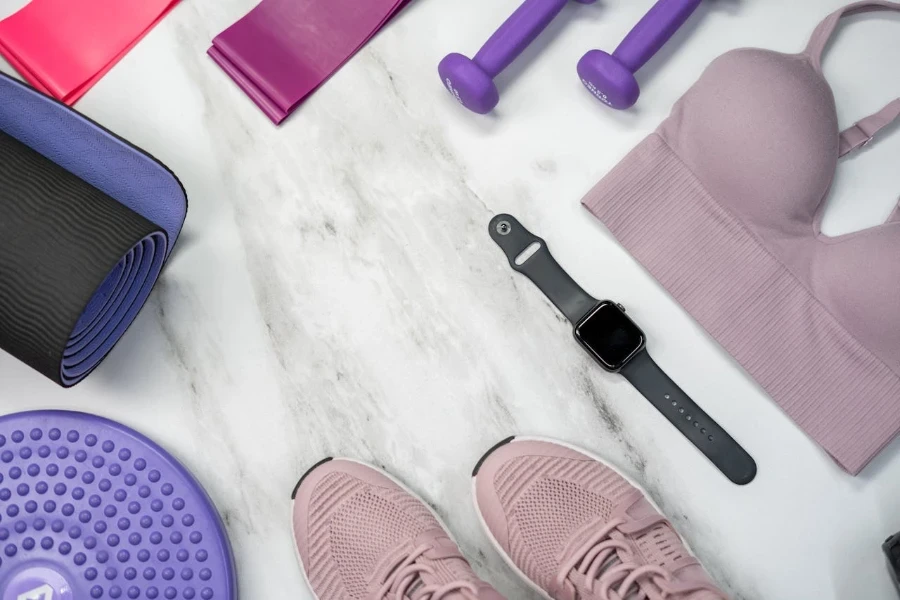If you’re a tech business selling consumer electronics, you need to sell smartwatches! These devices are not just a fad; they represent a significant opportunity for tech businesses to tap into a rapidly growing market. If you’re not already selling smartwatches, now is the time to jump on board, and here we’ll tell you exactly why.
Table of Contents
The growing market for smartwatches
Why you need to be selling smart watches
How to choose the best smart watches
Final thoughts
The growing market for smartwatches
Let’s start with the numbers. The smartwatch market has been experiencing robust growth in recent years, and the trend shows no signs of slowing down.
According to Statista, global smartwatch shipments are projected to reach 184 million units by the end of 2024, up from 141 million units in 2020. Additionally, smartwatches are projected to reach a revenue of USD 47.94 billion in 2024, and the average revenue per use (ARPU) is estimated to be USD 213.70.
The wearable technology market was valued at USD 61.30 billion in 2022 and is expected to grow at a compound annual growth rate (CAGR) of 14.6% from 2023 to 2030.
One of the driving factors behind this growth is the increasing adoption of wearable technology among consumers. Smartwatches offer a convenient and accessible way to stay connected, track fitness metrics, and access a range of useful applications, all from the convenience of your wrist. As consumers become more health-conscious and tech-savvy, the demand for smartwatches is only expected to rise.
Why you need to be selling smart watches

Outside of just looking at the numbers and the growth we see in the wearable technology market, there are several other reasons you need to add smartwatches to your product lineup if you haven’t already.
Expanding your product portfolio
As a tech business, diversifying your product portfolio is essential for staying competitive and meeting the evolving needs of your customers. Adding smartwatches to your lineup can help you appeal to a broader audience and capture new market segments.
For example, consider the case of XYZ Electronics, a company known for its smartphones and tablets. By introducing a line of smartwatches, XYZ Electronics leveraged its existing brand reputation and customer base to drive sales in a new product category. By offering a more comprehensive range of products, they were able to increase revenue and enhance customer loyalty.
Meeting consumer expectations
In this hyper-connected world, consumers expect seamless integration between their devices. Smartwatches play a crucial role in this ecosystem as a bridge between smartphones, tablets, and other smart devices. By offering compatibility with popular operating systems like iOS and Android, smartwatches allow users to easily access notifications, make calls, and control connected devices.
Moreover, smartwatches increasingly incorporate advanced features such as health monitoring, GPS tracking, and contactless payments. These functionalities enhance the user experience, address key pain points, and provide tangible benefits to consumers.
Seizing opportunities in health and fitness

The health and fitness industry represents a lucrative market for smartwatches, with consumers increasingly turning to wearable devices to track their activity levels, monitor their health, and achieve their fitness goals. According to a report by Allied Market Research, the global wearable fitness technology market is projected to reach USD 124 billion by 2028, with smartwatches playing a significant role in driving growth.
Smartwatches offer a wide range of health and fitness features, including heart rate monitoring, sleep tracking, and workout tracking. These capabilities appeal to fitness enthusiasts and attract health-conscious consumers looking to improve their overall well-being.
By positioning your smartwatches as essential tools for health and fitness, you can capitalize on this growing trend and differentiate your products from the competition.
How to choose the best smart watches
When determining which smartwatches to carry in your online store, you should consider a variety of factors to ensure the products meet the needs and preferences of your target customers.
Here are some key factors to consider:
Target audience
Understand your target audience’s demographics, preferences, and lifestyle. Consider age, gender, income level, occupation, and tech-savviness to determine which smartwatches resonate with your existing customer base.
For example, fitness enthusiasts are looking for watches with advanced fitness tracking capabilities, GPS tracking, heart rate monitoring, and built to withstand the outdoors, like a Garmin. While business professionals are likely seeking a watch that seamlessly integrates with their other devices to keep them connected on the go, like an Apple Watch.
Brand reputation
Partner with reputable and established brands known for producing high-quality smartwatches with reliable performance and durability. Consider factors such as brand reputation, customer reviews, and industry accolades to gauge the credibility and trustworthiness of potential suppliers.
Feature set
Evaluate the features and functionalities offered by different smartwatches to ensure they align with the needs and preferences of your target audience. Consider factors such as fitness tracking capabilities, health monitoring sensors, battery life, water resistance, GPS tracking, connectivity options, and compatibility with smartphones and other devices.
While you want the smart watches you carry to have robust features, you need to keep in mind the specific features your target audience is seeking, as mentioned previously.
By offering a diverse selection of smart watches tailored to different audience segments, businesses can appeal to a broader range of customers and meet their specific needs and preferences. Additionally, providing clear product descriptions, comparison charts, and user reviews can help customers make informed purchasing decisions and enhance their overall shopping experience.
Price range
Offer a range of smartwatches at different price points to cater to customers with varying budgets and preferences.
The prices of smart watches can vary widely depending on factors such as brand, features, materials, and design. Generally, smart watches are available in the following common price ranges:
- Entry-level smart watches ($50–$150): These smart watches offer basic functionalities such as fitness tracking, notifications, and simple health monitoring features. They are typically made of plastic or lightweight materials and may have a shorter battery life compared to higher-end models.
- Mid-range smart watches ($150–$300): Mid-range smart watches offer a balance of features and affordability, appealing to consumers who seek a combination of functionality and value. These watches often include more advanced fitness tracking capabilities, longer battery life, and improved build quality compared to entry-level models.
- Premium smart watches ($300+): Premium smart watches are characterized by their advanced features, high-quality materials, and craftsmanship. These watches may offer cutting-edge health monitoring sensors, LTE connectivity, premium materials such as stainless steel or titanium, and customizable design options. They are typically marketed toward tech enthusiasts, fashion-conscious consumers, and professionals who prioritize performance and style.
Consider factors such as pricing strategy, profit margins, and competitive pricing analysis to determine the optimal price range for your product lineup.
Design and aesthetics
Consider smartwatches’ design, aesthetics, and form factor to ensure they appeal to your target audience’s sense of style and personal taste. Some popular design options include:
- Sporty and rugged: Designed for active lifestyles, sporty smartwatches feature durable materials, rugged construction, and bold, athletic designs. They often incorporate features such as shock resistance, water resistance, and rubber or silicone straps for added durability and comfort during workouts or outdoor activities.
- Fashion-forward: Fashion-conscious consumers appreciate smartwatches that blend style and technology seamlessly. These watches often feature sleek, minimalist designs, premium materials such as stainless steel or leather, and customizable watch faces and straps to complement individual tastes and outfits.
- Tech-forward: For tech enthusiasts, smartwatches with futuristic designs and advanced features are a must-have accessory. These watches may feature bold, modern designs, touchscreen displays, and high-tech materials such as ceramic or carbon fiber, making a statement while offering cutting-edge functionality.
Smart watches come in various shapes and designs to cater to different preferences and styles. Some of the common smart watch shapes include:
- Rectangular: Rectangular smart watches are perhaps the most traditional and widely recognized design. They typically feature a rectangular or square-shaped display screen and are favored for their classic and familiar appearance. Many popular smart watches, including the Apple Watch and Samsung Galaxy Watch, adopt this shape.
- Circular: Circular smart watches mimic the design of traditional analog watches, featuring a round dial or display screen. These watches often appeal to consumers who appreciate the classic aesthetic of analog timepieces while enjoying the functionality of a smart watch. Popular examples include the Samsung Galaxy Watch Active series and the Huawei Watch GT series.
- Rounded rectangle: Rounded rectangle smart watches combine elements of both rectangular and circular designs, featuring a display screen with rounded corners. This design offers a balance between modern aesthetics and practical usability, providing ample screen space for notifications and apps while maintaining a sleek and stylish appearance. The Fitbit Versa series and Garmin Venu series are examples of smart watches with rounded rectangle shapes.
- Oval: Oval smart watches feature an elongated oval or egg-shaped design, offering a unique and distinctive look compared to more traditional shapes. These watches may appeal to consumers seeking a sleek and unconventional style statement. While less common than rectangular or circular shapes, oval smart watches like the Amazfit Bip series offer a refreshing alternative for those looking to stand out from the crowd.
When choosing which smart watches to sell, offer a variety of designs, colors, materials, and watch faces to provide customers with options that suit their preferences and fashion sense. This should also apply to the accessories you carry, such as smart watch straps.
Ecosystem compatibility
Ensure that the smartwatches you carry are compatible with popular operating systems (e.g., iOS, Android) and ecosystem integrations (e.g., Apple Health, Google Fit). Compatibility with third-party apps and services can enhance the versatility and utility of smartwatches and provide a seamless user experience across different devices and platforms.
Customer support and warranty
Partner with suppliers that offer comprehensive customer support and warranty coverage to address any issues or inquiries that may arise post-purchase. Consider factors such as warranty duration, return policies, repair services, and the responsiveness of customer support channels to ensure a positive customer experience and build trust and loyalty.
Market trends and demand
Stay informed about market trends, consumer preferences, and demand dynamics to anticipate shifts in the smartwatch market and adjust your product lineup accordingly. Monitor industry reports, consumer surveys, and sales data to identify emerging trends, popular features, and in-demand models that can inform your product selection and inventory management strategies.

Final thoughts
The case for selling smartwatches is clear. With a rapidly growing market, expanding consumer expectations, and opportunities for innovation, smartwatches represent a compelling opportunity for tech businesses to diversify their product portfolios and drive growth.
By embracing this trend and incorporating smartwatches into your lineup, you can stay ahead of the competition, meet your customers’ evolving needs, and position your business for long-term success in the dynamic world of consumer electronics.





 Afrikaans
Afrikaans አማርኛ
አማርኛ العربية
العربية বাংলা
বাংলা Nederlands
Nederlands English
English Français
Français Deutsch
Deutsch हिन्दी
हिन्दी Bahasa Indonesia
Bahasa Indonesia Italiano
Italiano 日本語
日本語 한국어
한국어 Bahasa Melayu
Bahasa Melayu മലയാളം
മലയാളം پښتو
پښتو فارسی
فارسی Polski
Polski Português
Português Русский
Русский Español
Español Kiswahili
Kiswahili ไทย
ไทย Türkçe
Türkçe اردو
اردو Tiếng Việt
Tiếng Việt isiXhosa
isiXhosa Zulu
Zulu